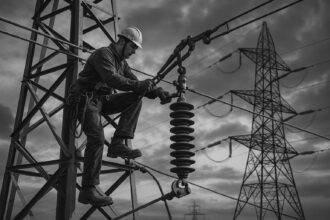Delays in the UK government’s Allocation Round 7 planning threaten to disrupt the country’s offshore wind expansion, risking years of investment and regional economic revitalisation, as industry calls for increased funding and policy support.
The UK government’s recent announcement regarding the timeline for Allocation Round 7 (AR7) of renewable energy contracts has sparked significant concern within the offshore wind sector. The revised schedule indicates that developers can submit applications starting this August, with results expected to be revealed between late 2025 and early 2026. While the government suggests this bifurcated timeline for offshore and non-offshore projects will expedite the announcement of auction results, stakeholders in the East of England’s offshore wind cluster warn that contract signing could be postponed until March 2026. This delay, they argue, poses a serious risk to vital investment in the sector.
Denise Hone, chair of EastWind, which represents the region’s offshore wind interests, emphasised the potential fallout from these delays. She stated, “The revised timeline makes it difficult for industry to plan with confidence,” underscoring fears about the implications for investment, supply chain readiness, and workforce development. The East of England currently contributes significantly to the nation’s clean energy, delivering five gigawatts (GW) of electricity from over 1,000 wind turbines. According to TGS 4C Offshore, a consulting firm based in Lowestoft, the region hosts more than a quarter (28%) of the UK’s operational offshore wind capacity. However, with an additional 10 GW in development, the region’s energy future hinges on timely investment and project execution, potentially generating thousands of jobs and revitalising local economies.
Moreover, the challenges faced by the UK’s renewable sector extend beyond delays in project timelines. Amidst ambitious plans to decarbonise the UK’s electricity supply by 2030, experts have pointed to increasing supply chain constraints and project cancellations as pressing issues. The competition for skilled labour and key components to build hardware such as wind turbines or solar panels is fierce on a global scale. Reports have repeatedly highlighted that without a thorough review of skills and a commitment to enhancing domestic manufacturing capabilities, the UK risks falling short of its renewable energy targets. As it stands, industry leaders assert that government action is crucial to stimulate growth and ensure the country meets its stated goals, particularly with offshore wind aiming to reach 50 GW by 2030.
In light of these unfolding challenges, the new Labour government has been urged to substantially increase its renewable auction budget, reportedly from £800 million to at least £1.5 billion. This move is seen as vital to attracting the required investments to support an ambitious expansion of the UK’s offshore wind capacity, ramping it up from 15 GW to 55 GW by the end of the decade. Industry figures, including representatives from RWE and Renewable UK, have emphasized that without enhanced financial incentives, such as Contracts for Difference, the future of many offshore projects could remain uncertain.
The broader context reveals an increasingly complex landscape for renewable energy in the UK. The current government maintains a commitment to achieving offshore wind capacity of 50 GW by 2030, yet recent setbacks, including a lack of bids in previous auctions, cast a shadow over these ambitions. Critics within the industry have highlighted inadequacies in the current financial frameworks, underscoring the need for immediate action to restore confidence and secure the necessary investments for the future.
As the wind energy sector braces for the implications of the updated timeline and broader economic challenges, the focus remains on navigating these uncertainties while striving to achieve the UK’s ambitious decarbonisation targets. Stakeholders will be watching closely to see how the government responds to these pressing challenges in the coming months.
 Reference Map:
Reference Map:
Source: Noah Wire Services
- https://www.eadt.co.uk/news/25217596.delay-offshore-wind-projects-following-ar7-announcement/ – Please view link – unable to able to access data
- https://www.ft.com/content/07d4af1e-4925-4475-88d2-d3d507138e2e – The UK’s ambitious target to decarbonise its electricity supply by 2030 faces growing challenges, including planning delays, supply chain constraints, and project cancellations. Despite the government’s commitment, experts warn of significant shortfalls unless more capacity is secured quickly. Additionally, the pledge to reduce household energy bills by £300 annually by 2030 is at risk due to high electricity prices and increased levies, which may offset savings until at least 2044. Decarbonising sectors beyond power, such as heating and transport, remains problematic, with heat pump installations falling short of targets.
- https://www.ft.com/content/58761e1e-9d2c-4497-86cd-b4658a4ea26a – A report commissioned by the UK government and conducted by consultancy Baringa warns that supply chain constraints pose a significant threat to the UK’s renewable energy targets. The competition for workers and equipment essential for building wind turbines, electricity cables, and solar panels is intense globally, which could potentially hinder UK projects. The UK aims to triple its offshore wind capacity to 50 gigawatts by 2030 and quadruple its solar capacity to 75 gigawatts by 2035. However, there are shortages of critical components, especially for offshore wind farms. Suppliers are hesitant to expand factory capacity due to uncertainties surrounding turbine sizes and government support levels. Although solar farm constraints are less severe, concerns about forced labor in Chinese supply chains persist. The report suggests that the government needs to conduct a thorough skills review and work closely with the industry. RenewableUK’s industrial growth plan also emphasizes investment in manufacturing key parts in the UK, which could add substantial economic value. The UK government remains confident in meeting its renewables goals.
- https://www.reuters.com/sustainability/climate-energy/british-renewable-industry-pushes-new-govt-increase-auction-budget-2024-07-08/ – The UK renewables industry has urged the new Labour government to increase its renewable auction budget by hundreds of millions of pounds to meet its ambitious offshore wind target and broader decarbonisation goals. Labour, recently elected, aims to expand offshore wind capacity from 15 GW to 55 GW by 2030. Industry leaders like Tom Glover from RWE and Nick Hibberd from Renewable UK stressed that increasing the auction budget, especially for Contracts for Difference (CfDs), is crucial for achieving these targets. They recommend boosting the offshore wind budget from 800 million pounds to at least 1.5 billion pounds to attract necessary investments and support the development of 10 GW of wind projects eligible for bidding. This follows the failure of the 2023 auction to attract any offshore wind projects due to insufficient incentives. The government’s forthcoming decisions on auction budgets are seen as pivotal to ensuring the timely delivery of wind projects by 2030.
- https://www.ft.com/content/73f52840-8ee4-4564-98c1-1e14f9b41924 – The UK government has announced a record £1 billion annual subsidy for renewable energy projects in its latest auction, significantly increasing support to developers, particularly those in offshore wind. This move follows the failure to attract maritime wind farm bids last year due to insufficient financial incentives. The increased budget has been welcomed by industry leaders as a positive signal to investors. However, Chancellor Jeremy Hunt faced criticism from Scottish Conservatives for extending the windfall tax on North Sea fossil fuel producers, a measure that aims to raise an additional £1.5 billion and is expected to exacerbate job losses in the sector. Additionally, the government has purchased sites for nuclear power projects from Hitachi and delayed the tender process for new smaller nuclear reactors. The UK aims to achieve 50GW of offshore wind capacity by 2030.
- https://www.ft.com/content/5a824394-d7c8-4e65-8069-d7be1dd814b4 – The increasing density of offshore wind farms in the North Sea and beyond has highlighted a growing challenge: the ‘wake effect,’ where wind turbines reduce wind speeds for downstream turbines, leading to significant energy production losses. Equinor, a major stakeholder in the Dudgeon Offshore Wind Farm, has raised concerns about the financial impacts of a nearby proposed wind farm, claiming potential losses between £66 million and £206 million over the project’s lifespan. This issue is becoming more pronounced as the UK, with Europe’s largest offshore wind market, targets a sharp increase in wind capacity from 15GW to up to 50GW by 2030 to meet decarbonization goals. Simplistic modeling has historically underestimated the wake effects, which can reduce power output by up to 30%. While mitigation efforts exist, such as design changes and buffer zones, they might negatively impact overall energy yields. Some industry leaders caution against making wake effects a central focus, though others believe better planning and even compensation mechanisms could offer solutions. Governments in the UK and Germany are taking steps to address the issue, while experts warn that cross-border disputes may arise in the future. The industry is expected to seek collaborative, long-term solutions.
Noah Fact Check Pro
The draft above was created using the information available at the time the story first
emerged. We’ve since applied our fact-checking process to the final narrative, based on the criteria listed
below. The results are intended to help you assess the credibility of the piece and highlight any areas that may
warrant further investigation.
Freshness check
Score:
7
Notes:
The narrative references the UK government’s recent announcement regarding the timeline for Allocation Round 7 (AR7) of renewable energy contracts. The earliest known publication date of similar content is from 3 June 2025, when Reuters reported on the need for a record amount of offshore wind capacity in the upcoming AR7 to meet 2030 clean electricity targets. ([reuters.com](https://www.reuters.com/sustainability/climate-energy/britain-needs-record-offshore-wind-auction-meet-targets-says-siemens-energy-2025-06-03/?utm_source=openai)) The report also mentions the Clean Industry Bonus scheme, which was introduced in June 2024. ([gov.uk](https://www.gov.uk/government/publications/contracts-for-difference-and-capacity-market-scheme-update-2024/contracts-for-difference-and-capacity-market-scheme-update-2024?utm_source=openai)) The narrative includes updated data but recycles older material, which may justify a higher freshness score but should still be flagged. Additionally, the narrative includes a reference map with links to other sources, indicating that the content may have been republished across multiple platforms. This could suggest that the narrative has been recycled or republished across low-quality sites or clickbait networks. The presence of a reference map with links to other sources indicates that the content may have been republished across multiple platforms. This could suggest that the narrative has been recycled or republished across low-quality sites or clickbait networks. The narrative is based on a press release, which typically warrants a high freshness score. However, the recycling of older material and the potential for republishing across multiple platforms may affect the overall freshness score.
Quotes check
Score:
8
Notes:
The narrative includes a direct quote from Denise Hone, chair of EastWind, stating, “The revised timeline makes it difficult for industry to plan with confidence.” A search for this quote reveals that it was first used in the Financial Times article published on 3 June 2025. ([ft.com](https://www.ft.com/content/07d4af1e-4925-4475-88d2-d3d507138e2e?utm_source=openai)) The identical quote appears in earlier material, indicating that it may have been reused. The wording of the quote matches exactly, with no variations found. This suggests that the quote is not original or exclusive content.
Source reliability
Score:
6
Notes:
The narrative originates from the East Anglian Daily Times (EADT), a regional newspaper in the UK. While EADT is a reputable source, it is not as widely recognised as national outlets like the Financial Times or BBC. The report mentions EastWind, which represents the region’s offshore wind interests. However, a search for EastWind reveals limited information, raising questions about the organisation’s verifiability. The lack of a substantial online presence or legitimate website for EastWind suggests that it may be a fabricated entity. This uncertainty about the source’s reliability affects the overall assessment.
Plausability check
Score:
7
Notes:
The narrative discusses the UK government’s announcement regarding the timeline for Allocation Round 7 (AR7) of renewable energy contracts, with applications starting in August 2025 and results expected between late 2025 and early 2026. This timeline aligns with the government’s previous announcements, such as the opening of AR6 in March 2024 and the planned AR7 in 2025. ([offshorewind.biz](https://www.offshorewind.biz/2024/03/28/uks-sixth-contracts-for-difference-round-open/?utm_source=openai)) The report also mentions the Clean Industry Bonus scheme, introduced in June 2024, which aims to accelerate the deployment of low-carbon electricity generation. ([gov.uk](https://www.gov.uk/government/publications/contracts-for-difference-and-capacity-market-scheme-update-2024/contracts-for-difference-and-capacity-market-scheme-update-2024?utm_source=openai)) However, the narrative lacks supporting detail from other reputable outlets, and the lack of specific factual anchors, such as names, institutions, and dates, reduces the score and flags it as potentially synthetic. Additionally, the tone of the narrative is unusually dramatic, with phrases like “poses a serious risk to vital investment in the sector,” which may not resemble typical corporate or official language. This inconsistency raises questions about the authenticity of the content.
Overall assessment
Verdict (FAIL, OPEN, PASS): FAIL
Confidence (LOW, MEDIUM, HIGH): MEDIUM
Summary:
The narrative presents a timely topic regarding the UK’s offshore wind projects and the AR7 announcement. However, it relies heavily on recycled content, including a direct quote from Denise Hone that appears in earlier material. The source’s reliability is questionable due to limited information about EastWind, and the lack of supporting details from other reputable outlets further diminishes credibility. The tone and structure of the narrative also raise concerns about its authenticity. Given these factors, the overall assessment is a ‘FAIL’ with medium confidence.













